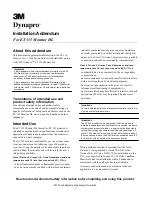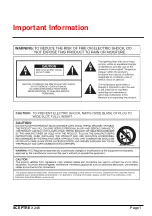
22
Image Video
Use the Image Video protocol setting when controlling the IMD from an Image Video tally controller (e.g. TSI-1000) or
other controlling device which utilizes the Image Video protocol. The
IMD #
,
IMD Name(S/N)
, and
Baud Rate
parameters must be set for each screen in conjunction with the controlling device.
TSL v4.0
Use the TSL v4.0 protocol setting when controlling the IMD from a TSL tally controller, or other controlling device which
utilizes the TSL v4.0 protocol. The IMD # must be set for each screen in conjunction with the controlling device.
MEI
Use the MEI protocol setting when controlling the V-R185-DLW using the Marshall Network Controller box. This
protocol allows remote control of all features on the V-R185-DLW, including marker setup, video configuration, system
configuration, and image adjustments (brightness, contrast, etc.). The
IMD #, IMD Group #,
and
Baud Rate
parameters
must be set in conjunction with the Network Controller Box.
MEI-Image Video
This protocol setting accepts Image Video commands
via
MEI protocol, for use when an Image Video controller is
connected to the Marshall Network Controller box.
■
Tally Source
The V-R185-DLW OSD tally can be controlled in a variety of different ways. Use the Tally Source setting to choose how tally is
controlled:
Standard
Use the Standard setting to control tally via contact closure on the HD-15 tally interface.
Image Video HW
Use the Image Video HW setting to control Image Video tally states via contact closure on the HD-15 tally interface.
Contact closure of the
Red
pin corresponds to
Image Video Tally 1
, and the
Green
pin maps to
Image Video Tally 2
.
Contact closure (ground) corresponds to a LOW state, and open circuit corresponds to a HIGH state. This mode requires
the IMD Tally Mode parameter to be set. Consult Image Video documentation for further information.
Image Video 422
Use the Image Video 422 setting to control Image Video tally states via the Image Video serial protocol. OSD tally will be
disabled in this mode, as Image Video tally states are manifested in the text color and other parameters. This mode
requires the IMD Tally Mode parameter to be set. Consult Image Video documentation for further information.
St IV422
Use the Image Video 422 setting to control Image Video tally states via the Image Video serial protocol, while controlling
OSD tally using contact closure on the HD-15 tally interface. This mode requires the IMD Tally Mode parameter to be
set. Consult Image Video documentation for further information.
TSL/MEI 422
Use the TSL/MEI 422 setting to control OSD tally via the TSL or Marshall serial protocols.
■
IMD Baud Rate
Use this setting to choose the baud rate. The baud rate must be set in conjunction with the controlling device. Available baud
rates are
300
,
600
,
1200
,
2400
,
4800
,
9600
,
19200
,
38400
,
57600
,
115200
. The TSL v4.0 protocol is fixed at 38400 bauds.
■
IMD Name (S/N)
Use this setting to assign a name to each screen when using the Image Video or Marshall-IV protocols.
The IMD name is
equivalent to the Image Video serial number and is used by the Image Video controlling device to identify each screen.
The
15
Use this setting to choose the default color displayed on the screen when no video input is present. Available colors are
blue
,
red
,
green
,
white
, and
black
.
■
Delete Gamma
Use this function to delete any customized User calibration that has been loaded on to the system via Marshall Electronics’
custom calibration application. Please contact Marshall Electronics for more information.
■
Framelock Mode
Framelock is used to designate the selected input as a reference for synchronizing image scaling when using the DLW
monitor. This allows the monitor to use a known-stable input source as a reference-lock to the entire system. In some
conditions, turning OFF the framelock mode will reduce the time needed for image lock.
■
2xHD Link Select
When displaying a 2xHD over 3G signal, this function allows you to select between the Link A and Link B channel. When the
signal is not a valid 2xHD signal, this function will do nothing.
■
Analog Phase (DVI-Analog or VGA input only)
Adjusts the analog phase value to improve picture quality on DVI-A or VGA Sources. This adjusts the signal phase (not color
phase) of the analog-to-digital conversion.
• 0-31 (value)
■
DVI-A CSC Mode (DVI-Analog input only)
Use the DVI-A CSC Mode to accommodate for four different types of colorspace inputs. This setting will only affect your DVI-
A inputs.
•
RGB Studio: accommodates digital 480i video using the RGB limited range (16-235) inputs.
•
RGB PC: accommodates full range RGB (0-255) inputs.
•
YUV 601: accommodates for Rec. 601 SDTV YUV colorspace inputs.
•
YUV 709: accommodates for Rec. 709 HDTV YUV colorspace inputs.
The monitor’s default setting is RGB PC.
■
DVI-D CSC Mode (DVI-D input only)
Use the DVI-D CSC Mode to accommodate for four different types of colorspace inputs. This setting will only affect your DVI-
D and HDMI inputs.
•
RGB Studio: accommodates digital 480i video using the RGB limited range (16-235) inputs.
•
RGB PC: accommodates full range RGB (0-255) inputs.
•
YUV 601: accommodates for Rec. 601 SDTV YUV colorspace inputs.
•
YUV 709: accommodates for Rec. 709 HDTV YUV colorspace inputs.
The monitor’s default setting is RGB PC.
■
HDMI CSC Auto (HDMI input only, via the DVI-I interface)
Summary of Contents for V-R185-DLW
Page 4: ...4 33...
Page 6: ...6 31 Dimensions...




































